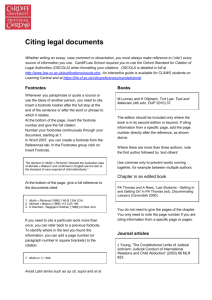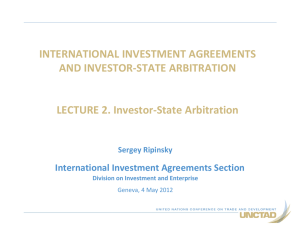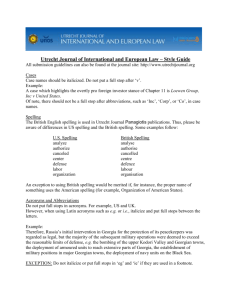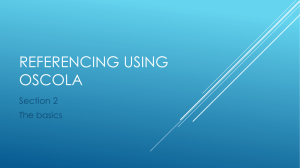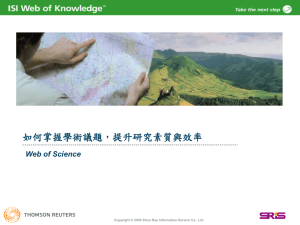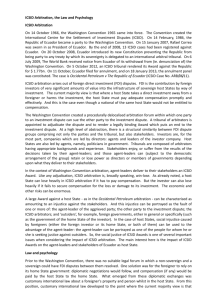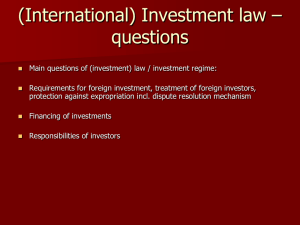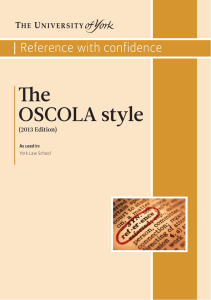Here - Oxford Journals
advertisement
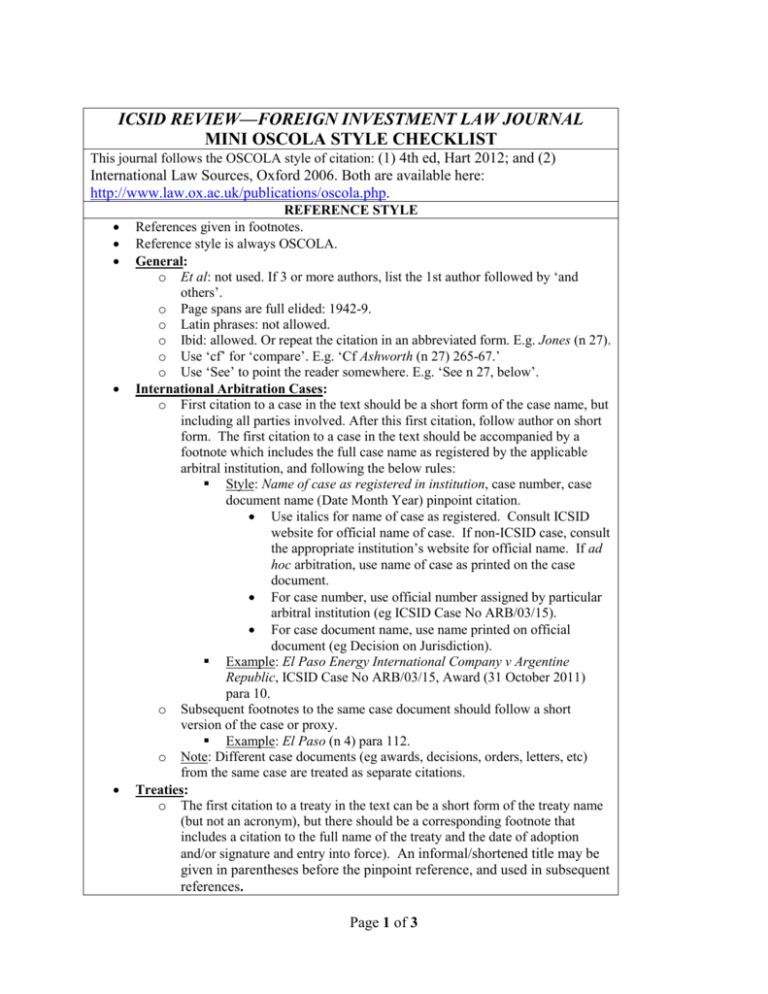
ICSID REVIEW—FOREIGN INVESTMENT LAW JOURNAL MINI OSCOLA STYLE CHECKLIST This journal follows the OSCOLA style of citation: (1) 4th ed, Hart 2012; and (2) International Law Sources, Oxford 2006. Both are available here: http://www.law.ox.ac.uk/publications/oscola.php. REFERENCE STYLE References given in footnotes. Reference style is always OSCOLA. General: o Et al: not used. If 3 or more authors, list the 1st author followed by ‘and others’. o Page spans are full elided: 1942-9. o Latin phrases: not allowed. o Ibid: allowed. Or repeat the citation in an abbreviated form. E.g. Jones (n 27). o Use ‘cf’ for ‘compare’. E.g. ‘Cf Ashworth (n 27) 265-67.’ o Use ‘See’ to point the reader somewhere. E.g. ‘See n 27, below’. International Arbitration Cases: o First citation to a case in the text should be a short form of the case name, but including all parties involved. After this first citation, follow author on short form. The first citation to a case in the text should be accompanied by a footnote which includes the full case name as registered by the applicable arbitral institution, and following the below rules: Style: Name of case as registered in institution, case number, case document name (Date Month Year) pinpoint citation. Use italics for name of case as registered. Consult ICSID website for official name of case. If non-ICSID case, consult the appropriate institution’s website for official name. If ad hoc arbitration, use name of case as printed on the case document. For case number, use official number assigned by particular arbitral institution (eg ICSID Case No ARB/03/15). For case document name, use name printed on official document (eg Decision on Jurisdiction). Example: El Paso Energy International Company v Argentine Republic, ICSID Case No ARB/03/15, Award (31 October 2011) para 10. o Subsequent footnotes to the same case document should follow a short version of the case or proxy. Example: El Paso (n 4) para 112. o Note: Different case documents (eg awards, decisions, orders, letters, etc) from the same case are treated as separate citations. Treaties: o The first citation to a treaty in the text can be a short form of the treaty name (but not an acronym), but there should be a corresponding footnote that includes a citation to the full name of the treaty and the date of adoption and/or signature and entry into force). An informal/shortened title may be given in parentheses before the pinpoint reference, and used in subsequent references. Page 1 of 3 Example 1: Convention on the Settlement of Investment Disputes between States and Nationals of Other States (opened for signature 18 March 1965, entered into force 14 October 1966) (‘ICSID Convention’) art 45. Example 2: Agreement between the Republic of France and the Republic of Austria on the Reciprocal Promotion and Protection of Investments (signed 12 March 1999, entered into force 16 October 2000) (‘France–Austria BIT’) art 11. Rules of Arbitration Institutions and Organizations: o First citation in the text can be a short form, eg ‘ICSID Arbitration Rule X‘, but there should be a corresponding footnote that includes a citation to the full name of the rules and contains the date of entry into effect. A short form can be used thereafter. Example 1: ICSID Rules of Procedure for Arbitration Proceedings (‘ICSID Arbitration Rules’) (April 2006) r 45. Example 2: IBA Rules on the Taking of Evidence in International Arbitration (‘IBA Rules’) (29 May 2010) art 4. Legislation: o Follow OSCOLA. Journal Articles: o Style: Author, ‘article title’ (publication date) volume ∙ OSCOLA abbreviation of journal title ∙ first page of article, pinpoint citation. o Example: Wenhua Shan, Norah Gallagher and Sheng Zhang, ‘National Treatment for Foreign Investment in China: A Changing Landscape’ (2012) 27 ICSID Rev—FILJ 120, 135. Books and Reports: o Style: Author(s) name, Title (edition publisher year) pinpoint citation. o Example 1: Gerald Aksen and others (eds), Global Reflections on International Law, Commerce and Dispute Resolution: Liber Amicorum in Honour of Robert Briner (ICC Publishing 2005) 601–53. o Example 2: Report of the Executive Directors on the Convention on the Settlement of Investment Disputes between States and Nationals of Other States (18 March 1965) paras 9–10. Chapter within Book or Report: o Style: Author, ‘article title’ in ∙ names of editors (eds), name of book (publisher, place ∙ year) pinpoint. o Example: Mark Tushnet, ‘Corporations and Free Speech’ in David Kairys (ed), The Politics of Law (Pantheon 1982) 253, 256. Press Releases: o Example: Foreign Affairs and International Trade Canada Press Release, ‘Minister Fast Highlights Successes of Prime Minister Harper-led Trade Mission to China’ (22 February 2012) 3 http://www.international.gc.ca/media_commerce/comm/news communiques/2012/02/22a.aspx?lang=eng&view=d accessed 10 May 2012. Newspapers and Magazines: o Example: Pablo Garibian and Rachelle Younglai, ‘Canada, Mexico Ask to Join Pan-Pacific Trade Talks’ Reuters (13 November 2011) 5 <www.reuters.com/article> accessed 16 March 2012 The Internet (HTML Websites): o Example: Australian Department of Foreign Affairs and Trade, ‘Fact Sheet on Page 2 of 3 the Investment Chapter of AUSFTA’ <link> accessed 3 August 2012. IN TEXT CITATIONS Format: superscript number. Footnote marker appears after all punctuation. No need to repeat case name in footnote if already given in the citation. QUOTATIONS More than 3 lines: displayed as separate text. No quotation marks. Use single quote marks. Double quotation marks for quotes within quotes. ABBREVIATIONS Accepted abbreviations for law reports, case names, journals and footnotes at the end of the style guide at http://denning.law.ox.ac.uk/published/oscola_2006.pdf Otherwise define at first mention. Page: numbers only Paragraph(s): para; paras Section: s Chapter: ch Volume: vol Number: no Article: art Rule: r PUNCTUATION Oxford/serial comma is allowed. Outside quotation marks (unless part of quotation). Use ‘eg’ and ‘etc’ (no punctuation). NUMBERS AND DATES Number spans partly elided, e.g. 526–29, 2005-06. Date format: 27 April 2005. CAPITALIZATION Use ‘Claimant’, ‘Respondent’, ‘Tribunal’, ‘ad hoc Committee’ for a particular case; and ‘Award’, ‘Decision’ or ‘Order’ for a particular case document. Use lower case if referring to multiple cases/case documents or if making reference to the term in the generic sense. ‘State’ or ‘States’ always capitalized if referring to a nation-State/country, either specifically or generically (eg the State of France, the State party to the dispute, investor–State dispute). Government capitalized if referring to a specific government (eg the French Government), but not capitalized if making reference to the term ‘government’ in the generic sense. Last revised 24 October 2012 Page 3 of 3
